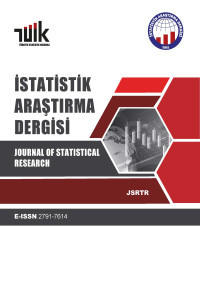Açıklayıcı ve Doğrulayıcı Faktör Analizlerinin Karşılaştırılması: Bir Uygulama
Çok Değişkenli İstatistik Yöntemlerden biri olan faktör analizi, aralarında ilişki bulunan çok sayıda değişkenin az sayıda faktörler şeklinde tanımlanmasını sağlamaktadır. Yöntem, çok sayıda değişkene ait özet bilgi vermekte ve boyut indirgeme ile sonuçların yorumlanmasını kolaylaştırmaktadır. Yaygın olarak iki faktör analizi yaklaşımı kullanılmaktadır. Bunlardan biri; Açıklayıcı Faktör Analizi, diğeri ise Doğrulayıcı Faktör Analizi’dir. Çalışmada her iki yaklaşım karşılaştırılmakta amaca uygun yaklaşımın seçimiyle ilgili genel bilgi verilmektedir.
Anahtar Kelimeler:
Açıklayıcı faktör analizi, Doğrulayıcı faktör analizi, Doğrulayıcı faktör analizi
Comparison of Exploratory and Confirmatory Factor Analysis: An Application
Factor analysis is one of the multivariate statistical methods that can be used to analyze interrelationships among large number of variables and to explain these variables into smaller set of factors. The method summarizes a special information that belongs to a large number of variables and facilitates the interpretation of the results with data reduction. There are two factor analysis approaches that are widely used. One of them is Explanatory Factor Analysis and the other is Confirmatory Factor Analysis. The aim of this study is to compare two approaches and to give general information about the selection process.
___
- Anderson T.W., Rubin H., 1956. Statistical inference in factor analysis, Proceedings of the third Berkeley Symposium on Mathematical Statistics and Probability, 5, 111-150, Berkeley: University of California Pres.
- Hair, J., Anderson R.,Tatham R., Black W., 1998. Multivariate data analysis, Prentice Hall, New Jersey.
- Hoyle, R., 1995. Structural equation modeling: Concepts, issues, and applications, Sage Publications,U.S.A.
- Howe, W.G., 1955. Some contributions to factor analysis, Oak Ridge, Tennesee.
- Joreskog, K.G., 1967. Some contributions to maximum likelihood factor analysis, Psychometrica, 32, 443-482.
- Joreskog, K.G., 1969. A general approach to confirmatory maximum likelihood factor analysis, Psychometrica, 34, 183-202.
- Joreskog, K.G., Lawley D.N., 1968. New methods in maximum likelihood factor analysis, British Journal of Mathematical and Statistical Psychology, 21, 85-96.
- Kaplan, D., 2000. Structural equation modeling foundations and extensions, Sage Publications, U.S.A, 2000.
- Kline R. B., 2005. Principles and practice of structural equation modeling, Second Edition (Methodology In The Social Sciences), The Guilford Press.
- Lawley, D.N., 1940. The estimation of factor loadings by the method of maximum likelihood, Proceedings of the Royal Society of Edinburgh, 60, 64-82.
- Lawley, D.N., 1958. Estimation in factor analysis under various initial assumptions, British Journal of Statistical Psychology,11,1-12.
- Long, J.S., 1983. Confirmatory factor analysis, Sage publication, A.B.D.
- Rencher, A., 1995. Methods of multivariate analysis, John Wiley & Sons, Kanada.
- Schumacker, R.E., 2004. Beginner’s guide to structural equation modeling, Lawrence Erlbaum Associates, A.B.D.
- Spearman, C., 1904. General intelligence, objectively determined and measured, American Journal of Psychology,15,201-293.
- Spearman, C., 1927. The abilities of man. London, Macmillan.
- Stevens, J., 1996. Applied multivariate statistics for the social sciences, 3. baskı, Lawrence Erlbaum, New Jersey.
- Tabachnick, B., Fidell L., 1996. Using multivariate statistics, Harper Collins, A.B.D.
- Tacq, Jacques, 1999. Multivarate technique in social sciences, Sage Publications, Great Britain.
- Thompson, Bruce, 2005. Exploratory and confirmatory factor analysis, American Psychological Association, A.B.D.
- Thurstone, L.,1947. Multiple factor Analysis, Chicago, University of Chicago Press.
- ISSN: 1303-6319
- Başlangıç: 2002
- Yayıncı: TÜİK
Sayıdaki Diğer Makaleler
Orman Yönetiminde Boolean Yaklaşımı
Özlem GÜRÜNLÜ ALMA, Serdar KURT, Aybars UĞUR
Hizmet Sektöründe Mali Başarısızlığın Modellenmesi
Özlem İLK, Murat ÇİNKO, Deniz AKINÇ, Didem PEKKURNAZ
Güçlü İkili Kovaryans Tahmincisinin Performans Değerlendirmesi
Yapısal Bağımlılık Altında Karmaşık MAPK Yolunun Bayesci Tahmini
Açıklayıcı ve Doğrulayıcı Faktör Analizlerinin Karşılaştırılması: Bir Uygulama
Kardeş Cinsiyet Bileşiminin Eğitimsel Erişimlere Etkisi
